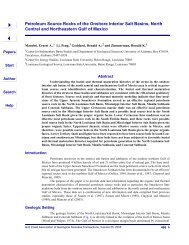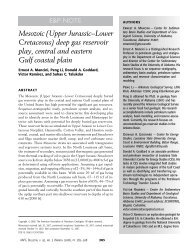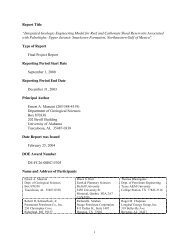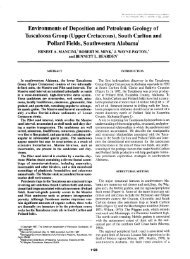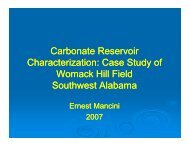Part 4 - Berg - Hughes Center
Part 4 - Berg - Hughes Center
Part 4 - Berg - Hughes Center
Create successful ePaper yourself
Turn your PDF publications into a flip-book with our unique Google optimized e-Paper software.
hydrocarbons contained within these traps. The dominant structural styles are salt-<br />
supported anticlines, normal faults, and combination structural-stratigraphic features.<br />
Combination structural-stratigraphic features include large regional domal structures,<br />
such as the Sabine and Monroe Uplifts.<br />
The main difference in the geohistories of the North Louisiana Salt Basin and the<br />
Mississippi Interior Salt Basin is the elevated heat flow the strata in the North Louisiana<br />
Salt Basin experienced in the Cretaceous due primarily to reactivation upward movement,<br />
igneous activity, and erosion associated with the Monroe and Sabine Uplifts. The Jackson<br />
Dome in the Mississippi Interior Salt Basin is a similar phenomenon, but the effects of<br />
this igneous intrusion are on a much lower level geographically.<br />
The Upper Jurassic Smackover petroleum system is the principal petroleum system in<br />
these basins. The underburden, source, overburden, reservoir, and seal rocks associated<br />
with this petroleum system are a result of the rift-related geohistory. The generation of oil<br />
and gas from Smackover lime mudstone was initiated during the Early Cretaceous in the<br />
southern part of the basins and continued into the Tertiary. Hydrocarbon expulsion and<br />
migration commenced during the Early Cretaceous and continued into the Tertiary.<br />
Vertical and lateral migration is important to the productivity of these basins. In the<br />
North Louisiana Salt Basin, petroleum reservoirs include continental, coastal, and marine<br />
sandstone facies and nearshore marine, shelf, ramp, and reef carbonate facies. Seal rocks<br />
include Upper Jurassic and Lower Cretaceous anhydrite and shale, Upper Cretaceous<br />
chalk and shale, and lower Tertiary shale.<br />
445




